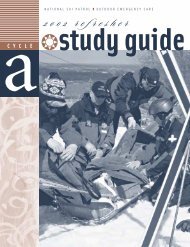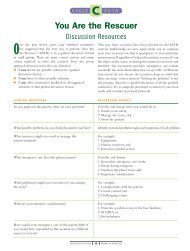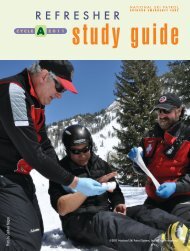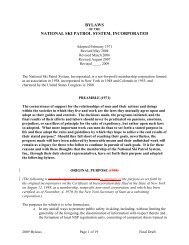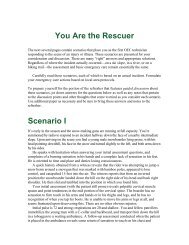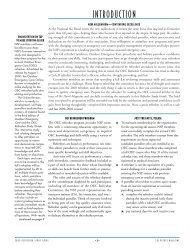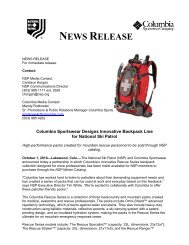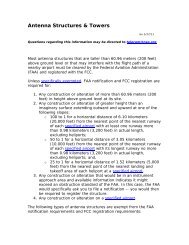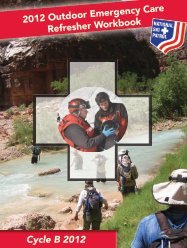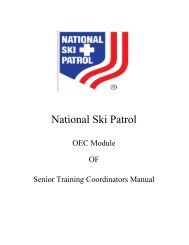Sierra Samaritans - National Ski Patrol
Sierra Samaritans - National Ski Patrol
Sierra Samaritans - National Ski Patrol
Create successful ePaper yourself
Turn your PDF publications into a flip-book with our unique Google optimized e-Paper software.
STRETCHING<br />
It’s never too early or too late in the season<br />
to get in the habit of stretching after a workout<br />
in order to keep the muscles loose. For<br />
example, throughout a day on the moun-<br />
CONTINUED ON PAGE 70<br />
photo 11<br />
PHOTOS BY LLOYD MULLER<br />
Single-leg Lunge<br />
photo 12<br />
Bosu Hops<br />
❚ CONTINUED FROM PAGE 33<br />
similar to the single-leg press, so you<br />
shouldn’t do both on the same day. Start<br />
with one foot on the floor and the other<br />
on a bench behind you. The foot on the<br />
floor should be far enough in front of you<br />
so that the front knee does not extend<br />
beyond the toes as you bend it (photo 11).<br />
Try to do 10 to 12 repetitions on each leg,<br />
switching legs after one set. This works the<br />
glutes, hip, and quadriceps, key muscles<br />
used in skiing and snowboarding. Once<br />
this gets easy, try it on the Bosu!<br />
ance. Use the following drills to test and<br />
improve your stability in motion.<br />
Jumps<br />
Use a solid stationary box such as a milk<br />
crate or a gym bench that is no more than<br />
a foot off the ground. Jump from the box<br />
to the ground and use the power from<br />
your leg muscles to propel you into the<br />
DYNAMIC BALANCE EXERCISES<br />
When you’ve developed good strength and<br />
stationary balance using the previous exercises,<br />
you’re ready to test your dynamic<br />
balance, or balance in motion. Obviously,<br />
when you’re skiing or riding, you’re not<br />
standing still. You’re moving downhill at<br />
high speeds and constantly adjusting your<br />
body and your center of mass, which<br />
means you’re constantly adjusting your<br />
balance. Jumping exercises that use the<br />
Bosu and stationary objects such as boxes<br />
or benches can help you simulate the situations<br />
you face on the mountain and help<br />
train your body to develop dynamic baltwo<br />
or more Bosus, hop from one to the<br />
next (photo 12). First hop forward with<br />
both feet. As you develop confidence and<br />
balance, jump laterally and then with one<br />
leg or the other. (If you have any kind of<br />
ankle problems, this exercise can be dangerous!<br />
Be sensible with this drill, and only<br />
do it if you’ve done other jumping exercises<br />
before.)<br />
Jumping exercises that use the Bosu and stationary objects<br />
such as boxes or benches can help you simulate<br />
the situations you face on the mountain.<br />
air. Concentrate on sticking the landing<br />
and absorbing the impact with your<br />
ankles and knees. Most likely, your body<br />
will teeter one way or the other, but the<br />
strength you’ve built up in your abs, back,<br />
and legs should help you adjust your<br />
body and keep you from falling over. Use<br />
your abs to hold your upper body upright<br />
and squared over your hips.<br />
Bosu Hops<br />
Agility and speed are important factors in<br />
dynamic balance, especially on the slopes<br />
where you might have to react quickly to<br />
changing conditions and terrain. Using<br />
It is best to first become adept on the<br />
box jumps, making sure you can plant<br />
your landing with both feet simultaneously.<br />
Allow yourself to develop in this<br />
skill, as it will help you in moguls and<br />
jumps on the slopes. It is important to get<br />
the feel of controlling your landings, so the<br />
knees don’t take the shock of the jumps.<br />
34 <strong>Ski</strong> <strong>Patrol</strong> Magazine | Winter 2005




